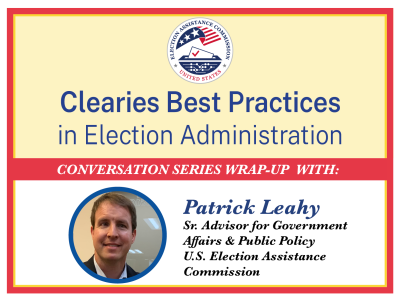
The EAC would like to thank all who entered the 2020 National Clearinghouse Awards competition, or Clearies, for best practices and innovations in election administration. The EAC Commissioners, judges, and staff were impressed with the ingenuity and resourcefulness of election officials from large to small jurisdictions who navigated record voter turnout in the middle of the COVID-19 pandemic. Their extraordinary efforts helped ensure successful 2020 elections.
The goal of the Clearies is not only to give recognition to these programs, but also, under the direction of the Help America Vote Act of 2002 (HAVA), to build a clearinghouse of information and encourage the exchange of practical ideas. With that in mind, Clearies judges evaluate submissions for replicability and cost-effectiveness in addition to categories such as outreach efforts and positive results. Many of the innovative strategies and best practices can be adjusted to suit the different needs of jurisdictions across the country.
EAC Commissioners recently conducted a series of virtual interviews with some of the 2020 Clearie winners. The series takes a closer look at proven best practices and features insight from election officials on the challenges they faced, feedback from voters and staff, as well as recommendations for officials who may wish to implement similar concepts in their communities. The interviews in this series are available on the EAC’s YouTube page.
Peg Perl of Arapahoe County, Colorado said in a recent EAC Clearie interview, “Thinking about where the voters are and what they're doing and what little tweaks you can do that actually don't cost a lot on your end and adjust your existing processes can really have an outsized impact on the individual voters themselves.”
The Clearies provided us with many lessons learned. Below are some common themes from the winning programs:
- Leveraging Partners and Resources: During interviews with election officials, one of the themes that stood out was resource sharing. For some offices, this meant coordinating with other governmental departments in the jurisdiction. The Durham County Board of Elections in North Carolina, for example, worked with their GIS department and used existing technology services to create new voter assistance tools at no cost to the elections office.
- Piloted Programs and Planning Foster Success: In many instances, election officials piloted new technology or processes in midterm or primary elections before full implementation. These trial runs allowed officials to fine-tune initiatives. Harris County, Texas, launched their Electronic Support Specialist Program in November 2019. A winner in the category of Best Practices for Recruiting, Retaining, and Training poll workers, the program trains high school students to help with election equipment. Extensive preparation allowed the county to carefully grow the initiative, helping to ensure sufficient poll workers for the 2020 elections.
- Utilizing Proven Concepts from the Private Sector: Jurisdictions took a cue from industry leaders to achieve their 2020 goals, leading to new voter assistance tools such as an online chat services and a text message system for election information. George Stern of Jefferson County, Colorado commented, “There are better ways that we can help our voters, sometimes they exist in the private sector… chat was something that was becoming pretty common outside of the government and elections world and we just had to lift up our heads and look for that innovation and ultimately, deliver a much better experience to our voters.”
- Keeping Elections Secure and Accessible: Winners from both large and small jurisdictions recognized the importance of making sure the elections were secure and accessible. Election officials in Canton Township, Michigan, implemented a four-pronged approach to improve training, customer service, and combat misinformation while keeping access for voters with disabilities at the forefront.
- Look In-House for Creative Solutions: Several jurisdictions made 2020 successful by modifying existing tools based on creative ideas from staff. Seminole County, Florida, one of our honorable mention winners, created their own in-house stylus for use at the polls. The solution kept voters safe while allowing the office to reallocate crucial cost-savings into other areas.
These election officials are excited to share their award-winning efforts and offer tips for getting similar initiatives underway. “One of the most important parts about this program is getting to hear about all of the other fantastic things that are happening around the country in improving election administration. We really appreciate the award and we really appreciate the opportunity to be able to learn from some of the other jurisdictions about other things that we can consider for the future,” said Meagan Wolfe of the Wisconsin Elections Commission in a Clearie interview about their Accessibility Advisory Committee.
From advancing cybersecurity training to helping those with access needs overcome voting obstacles, the 2020 Clearinghouse Awards are a testament to election officials’ tireless efforts. EAC Commissioners and staff are pleased to promote and celebrate the outstanding work of all Clearies entrants. Again, congratulations to all and especially to those recognized as Clearies honorees.
2020 Clearinghouse Awards Background
The 2020 winners were announced on March 4 after the EAC received a record-breaking 137 entries for the competition, tripling that of the previous year. Submissions were scored by two panels of judges from the EAC’s Standards Board and Board of Advisors. Awards were issued to 26 programs and an additional 15 were recognized in a new honorable mention category.
Honorees included jurisdictions of varying sizes, from large states with more than 8 million registered voters to townships of around 75,000 voters. Many of the programs were adapted or created in response to the pandemic, but the concepts behind them can help voters for years to come.
This was the fifth year for the Clearinghouse Awards. Under HAVA, the EAC is charged with serving as a clearinghouse for election administration information. To meet this challenge, we established the Clearie Awards in 2016, to celebrate and promote election officials’ contributions to best practices in election administration. We hope election officials, from both small and large jurisdictions, will consider entering in the 2021 Clearies.

